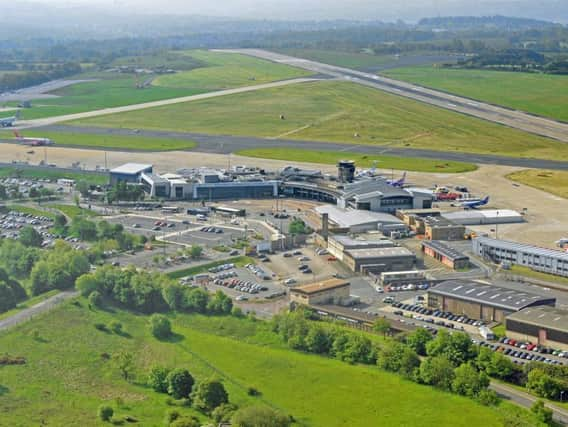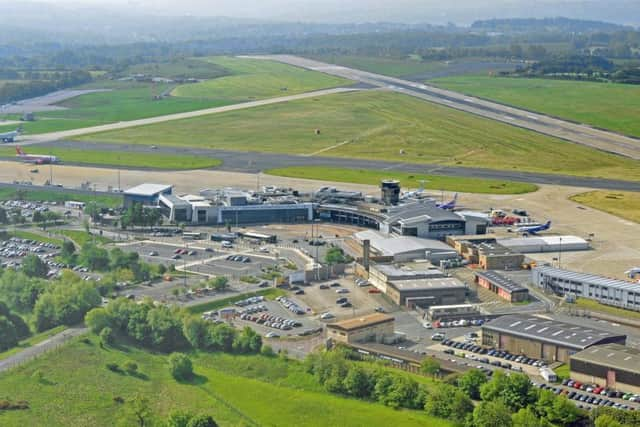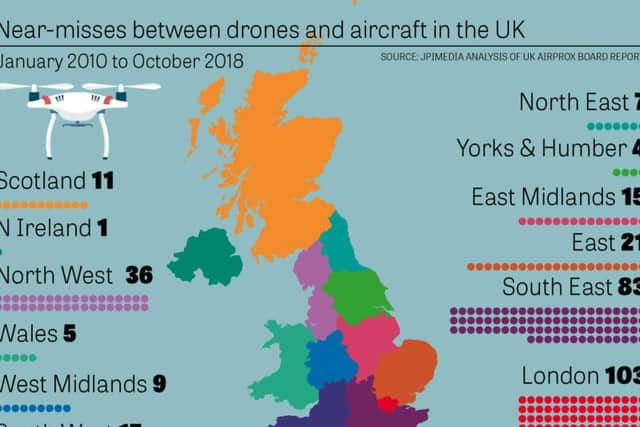Drone had near miss with Boeing 737 about to land at Leeds Bradford Airport


Tens of thousands of people were shopping at the time as the commercial jet had just started its descent to land at Leeds Bradford Airport.
Both crew members spotted a black-and-white, four-rotor helicopter-type drone flying at an altitude of 1,800ft to the left of them, far higher than the 400ft limit set out in regulations.
Advertisement
Hide AdAdvertisement
Hide AdIt was too late to change course and the pilot estimates the craft missed them by 1,000ft, although aviation experts believe it was probably closer, official reports show.


It would, of course, have been carnage had the drone collided with the plane, or become sucked into its propellers.
The UK Airprox Board, which investigates aeroplane near-misses, said the incident, shortly before 1.30pm on July 9, 2015, had meant “safety margins had been much reduced”.
The board said the drone was being ‘flown inappropriately’ and rated it a major incident, the second-highest severity level.


Advertisement
Hide AdAdvertisement
Hide AdToday the JPI Media Data Team, investigating for the Yorkshire Evening Post, reveals how this includes four near-accidents in Yorkshire and Humberside.
Drone sightings brought 36 hours of chaos to Gatwick Airport in the run-up to Christmas, with runways closed and 1,000 flights affected in what police described as a “deliberate act” of disruption.
But pilots had begun to report narrowly missing drones in the sky from 2010 onwards, analysis of hundreds of official reports shows.
Since the shutdowns, the Government has faced criticism that the events were foreseeable and more should have been done to prevent them.
Advertisement
Hide AdAdvertisement
Hide AdBut the Department for Transport has said there are already laws against such malicious acts.
Aviation Minister, Baroness Sugg, said: “The actions of these drone users were not only irresponsible, but illegal. The law could not be clearer that this is a criminal offence and anyone endangering others in this way faces imprisonment.
“Airports have measures in place to counter this threat. The Government is also increasing police powers to clamp down on drone misuse, and extending no-fly zones around airports to ensure our skies are safe.”
Two-thirds of the near-collisions seen in the UK so far involved commercial passenger flights, with drones frequently being flown above regulatory height limits or within restricted airport zones.
Advertisement
Hide AdAdvertisement
Hide Ad“Regarding day to day activity, we continue to have an excellent relationship with our local commercial drone operators which includes an effective booking process and operating procedures.”
Irresponsible drone operators are rarely tracked down, the UK Airprox (Aircraft Proximity) Board documents show.
In another incident, a passenger plane nearly crashed into what is believed to have been a bright yellow drone just before it touched down on the runway at Manchester Airport.
The two passed so close to each other that the object passed over the plane’s right wing.
Advertisement
Hide AdAdvertisement
Hide AdPolice were told about the alarming near-miss but the drone’s operator could not be found.
The UK Airprox Board’s official report into the incident, on July 20, 2016, says the pilot had been preparing to land and had reached an altitude of just 300ft when an object came “very close”.
It says: “It was at exactly the level of the flight deck window, and so close it must have passed over the right wing. The object was bright yellow and around 60cm across. Its shape was a very sharp-edged rectangle with a square below making a ‘T’.”
The board decided the object was “most likely a drone, perhaps with an underslung camera”.
Advertisement
Hide AdAdvertisement
Hide AdIts report added: “If that was indeed the case, then its operator had, by operating at that position and altitude, flown the drone into conflict and had recklessly endangered the B767.”
Although the current law barring drones within 1km of airports had not been in place at the time, operators were still required to make sure they did not endanger people or property.
The board said the pilot’s account of the near-miss “portrayed a situation where a collision had only been narrowly avoided and chance had played a major part”.
Jonathan Nicholson, of the CAA, said there was “no debate” that air travel remained the safest mode of transport but the authority wanted to remove any risk of conflict in the air.
Advertisement
Hide AdAdvertisement
Hide AdHe said: “There are some very clear reports from pilots where often drones have been flown well above 400ft. That is totally unacceptable and should not happen.”
“Any misuse of drones is absolutely unacceptable. We have always said that. That has been a constant message we have given to drone users: they must abide by the rules and they must abide by the Drone Code. It is very easy to abide by. It is not placing severe restrictions on them. If you do operate a drone, it should be very simple to comply with the rules.
“If you look at the drone forums, there is a huge disagreement between various elements of drone users and the aviation community about what is actually possible. So a lot of drone users would say getting a consumer-style drone up to those kinds of altitudes is impossible. Others say it isn’t. Certainly, some of the very high reports we get, it does sometimes perhaps call into question what has happened, in comparison to what we know is actually possible with a drone.
“We have an ongoing, extensive education programme for drone users that has been running for nearly three years now and have put a lot of effort into that. Commercial drone users go on a course and get education on the rules and regulations of exactly what they should do. For consumer users it is about education. We have seen a sizeable increase in public awareness of what the rules are.”
